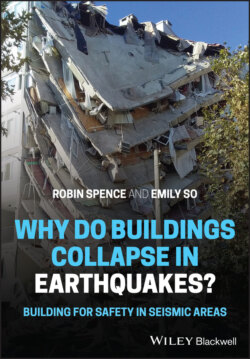Читать книгу Why do buildings collapse in earthquakes? Building for safety in seismic areas - Robin Spence - Страница 20
2.2.4 The 8.10.2005 Kashmir Earthquake in Pakistan: Mw = 7.6, 73 338 Deaths
ОглавлениеOn 8 October 2005 at 8.50 a.m. local time, an earthquake of magnitude Mw7.6 struck the Kashmir regions of Pakistan and India. The epicentre was a little north of Muzaffarabad, the major town of Pakistan's AJK (Azad Jammu and Kashmir) Province. It was located on the Jhelum Thrust (Tapponier et al. 2006), part of the well‐established thrust fault system associated with the subduction of the Indian plate below the Eurasian plate.
Heavy ground shaking was felt over a very wide area, and was devastating for the nearby towns of Muzaffarabad, Balakot, Bagh and Rawalakot; but damage was severe in towns up to 50 km away, including Murree, Abbotabad and Mansehra in Pakistan, and Uri and Baramulla in India. In the three worst‐affected districts of AJK (Muzaffarabad, Bagh and Rawalakot), 84% of buildings were damaged or destroyed. In Islamabad, 100 km away, a recently built multistorey RC apartment block collapsed (EERI 2005, 2006a) killing 74. As many as 5000 school buildings were seriously damaged or destroyed killing 18 095 students and 853 teachers (Asia Development Bank 2005; EEFIT 2008a). This was the most destructive event in the Indian subcontinent in the last 50 years, causing as many as 75 000 deaths and 68 700 serious injuries in Pakistan, and 946 deaths and 4400 injuries in India (EEFIT 2008a). Altogether, about 450 000 homes were destroyed, and over 2.8 million people were left homeless.
The high death toll was undoubtedly primarily due to the widespread collapse of buildings in the area, most of them of masonry. Because of the harsh climate, buildings have traditionally been made from thick stone masonry, often using rounded riverbed stones in poor‐quality mud mortar, with steel sheet or thick mud roofs (Figure 2.9). In the past, such walls were often tied together with timber lacings and the roof independently supported on timber columns. However, timber is less and less used because of its scarcity and high cost, and the severe ground shaking would have been more than enough to cause overturning or disintegration of the walls, followed by roof collapse. In many places, more modern building types using concrete blocks and RC frames also collapsed (Figure 2.10), and this included many government‐built schools and barracks. Evidence from post‐earthquake field investigations showed poor‐quality building standards (EEFIT 2008a).
Figure 2.9 2005 Kashmir earthquake: damage in the Muzaffarabad district. Aerial view of damage to traditional residential buildings.
Source: EEFIT. Reproduced with permission.
Figure 2.10 2005 Kashmir earthquake: damage in the Muzaffarabad district. Damage to reinforced concrete construction.
A factor which certainly also contributed to the high death toll was the inaccessibility of much of the mountainous affected area, as a result of the numerous landslides triggered by the earthquake blocking roads. The emergency services were thus very slow to arrive, and many of the survivors had to walk long distances in difficult terrain to reach a functioning health centre; this also complicated injuries, bringing on infections and resulting in more drastic medical measures. Many more victims with head and chest injuries from falling masonry did not survive until medical help arrived. Unfortunately, search and rescue capability in the crucial early stages was overly concentrated in Islamabad, where few buildings failed, rather than being sent to the epicentral area (So 2009).
There were no official data from which causes of death could be established, but a survey of survivors in 500 families in one of the worst affected neighbourhoods in Muzaffarabad was carried out by our team in conjunction with University of Peshawar (So 2009) to establish patterns and causes of death and injury. This confirmed that, whatever form of construction was used, the major cause of serious injury and death was structural collapse resulting in entrapment.
